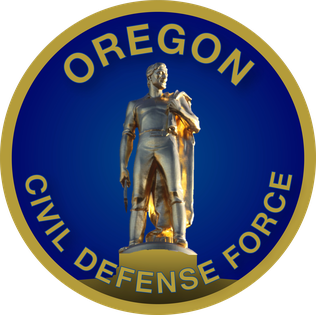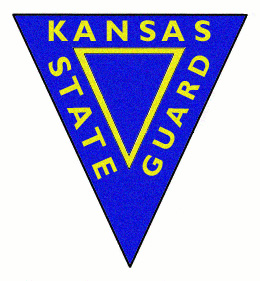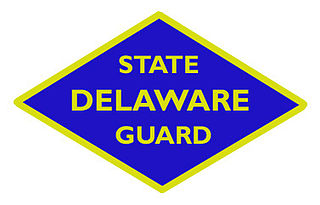
A militia is generally an army or some other fighting organization of non-professional soldiers, citizens of a country, or subjects of a state, who may perform military service during a time of need, as opposed to a professional force of regular, full-time military personnel; or, historically, to members of a warrior-nobility class. Generally unable to hold ground against regular forces, militias commonly support regular troops by skirmishing, holding fortifications, or conducting irregular warfare, instead of undertaking offensive campaigns by themselves. Local civilian laws often limit militias to serve only in their home region, and to serve only for a limited time; this further reduces their use in long military campaigns.

In the United States, state defense forces are military units that operate under the sole authority of a state government. State defense forces are authorized by state and federal law and are under the command of the governor of each state.

A naval militia is a reserve military organization administered under the authority of a state government in the United States. It is often composed of reservists of the Navy Reserve, Marine Corps Reserve, and Coast Guard Reserve, retirees and volunteers. They are distinguishable from the U.S. Coast Guard Auxiliary which is a federally chartered civilian volunteer component of the U.S. Coast Guard and falls under the command of the Commandant of the Coast Guard through the Chief Director of the Auxiliary, and the United States Maritime Service and United States Merchant Marine, both of which are federal maritime services.

The New York Guard (NYG) is the state defense force of New York State, also called The New York State Military Reserve. Originally called the New York State Militia it can trace its lineage back to the American Revolution and the War of 1812.

The militia of the United States, as defined by the U.S. Congress, has changed over time. During colonial America, all able-bodied men of a certain age range were members of the militia, depending on each colony's rule. Individual towns formed local independent militias for their own defense. The year before the US Constitution was ratified, The Federalist Papers detailed the founders' paramount vision of the militia in 1787. The new Constitution empowered Congress to "organize, arm, and discipline" this national military force, leaving significant control in the hands of each state government.

The Massachusetts National Guard is the National Guard component for the Commonwealth of Massachusetts. Founded as the Massachusetts Bay Colonial Militia on December 13, 1636, it contains the oldest units in the United States Army. What is today's Massachusetts National Guard evolved through many different forms. Originally founded as a defensive militia for Puritan colonists in the Massachusetts Bay Colony, the militia evolved into a highly organized and armed fighting force. The Massachusetts militia served as a central organ of the New England revolutionary fighting force during the early American Revolution and a major component in the Continental Army under George Washington.

The Wisconsin State Defense Force (WSDF) is the currently inactive state defense force of the State of Wisconsin authorized by Wisconsin law. As a state defense force, the Wisconsin State Defense Force, alongside the Wisconsin National Guard, is organized under the Wisconsin Department of Military Affairs as a part of the military forces of Wisconsin. However, unlike the National Guard, the State Defense Force is a purely state-controlled organization and cannot be deployed outside the state of Wisconsin. When any part of the Wisconsin National Guard is called into service of the United States, the adjutant general may recruit volunteers to the WSDF to serve within the borders of Wisconsin.

The Massachusetts State Defense Force (MSDF) was a state defense force of the Commonwealth of Massachusetts. It was inactivated in 2016 by Governor Charlie Baker. The purpose of the Massachusetts State Defense Force was to augment the Massachusetts National Guard during emergencies in the state, especially when some or all of the National Guard was deployed. The MSDF was an all-volunteer militia which reported to the State Adjutant General and was under the command of the Governor of Massachusetts. Members met for drills one weekend per month unless activated by the Governor during an emergency. The MSDF was headquartered at Milford, Massachusetts, in the same building as the Massachusetts National Guard. The director of the MSDF was appointed by The Adjutant General of Massachusetts (TAGMA). The Massachusetts State Defense Force was authorized by both the Constitution of Massachusetts and chapter 33 § 10 of the Massachusetts General Laws.

The South Carolina State Guard (SCSG) is the designated state defense force for the state of South Carolina.

The Rhode Island Army National Guard (RIARNG) is the land force militia for the U.S. state of Rhode Island. It operates under Title 10 and Title 32 of the United States Code and operates under the command of the state governor while not in federal service. National Guard units may function under arms in a state status, therefore they may be called up for active duty by the governor to help respond to domestic emergencies and disasters, such as those caused by hurricanes, floods, or civil unrest.

The Oregon Civil Defense Force (ORCDF), formerly known as the Oregon State Defense Force, is the official state defense force of Oregon and one of the three components of Oregon State's organized militia, with Oregon's Army and Air National Guard (ORNG) making up the other two. It serves as a state-level military and emergency services reserve force.

The Kansas State Guard was the official state defense force of the state of Kansas during each of the world wars. The unit was first created during World War I, and was later reactivated during World War II. When the Kansas National Guard was federalized and deployed during each of the world wars, the state of Kansas was forced to raise and maintain its own military force in order to protect against saboteurs, quell riots, and perform other duties which would normally fall to the National Guard. Unlike the National Guard, which could be federalized and deployed abroad, the State Guard was funded and equipped solely by the state and as such was immune to deployment. The Kansas State Guard is authorized under Kansas law. In 2007, the Kansas Legislature considered a bill which would create a modern Kansas State Defense Force. The bill did not pass.

The Delaware State Guard is the currently inactive state defense force of the state of Delaware, which was active during both World War I and World War II. As the official militia of the state, the Delaware State Guard was created with the intent of acting as a stateside replacement for the Delaware National Guard while the National Guard units were deployed abroad.

The Pennsylvania State Guard is the currently inactive official state defense force of the state of Pennsylvania, which was active during World War II and the Korean War. The unit was organized as a home guard composed of volunteers who were trained and organized as parallel to the state’s National Guard. As a part of Pennsylvania's official militia, the Pennsylvania State Guard was trained, organized, and funded by the state of Pennsylvania, answered to the governor, and could not be federalized or deployed abroad.
The Hawaii Territorial Guard was the state defense force of Hawaii during World War II. As a result of the National Guard of Hawaii being federalized for the duration of the war, the Hawaii Territorial Guard was created to serve as the stateside replacement for the National Guard. During the war, it was the sole military force available to the Governor of Hawaii as its captain general to use in defense of the state. Unlike the National Guard, as a state defense force, the Hawaii Territorial Guard was not subject to federalization or deployment outside of the borders of Hawaii, but rather answered only to the governor.
The Nebraska State Guard (NSG) is the currently inactive state defense force of the state of Nebraska, which was activated during both World War II and the Vietnam War. As a state defense force, the NSG served on as a component of the organized militia of Nebraska, serving as reservists who trained periodically but could be called up during an emergency; however, unlike the Nebraska National Guard, the Nebraska State Guard could not be federalized or deployed outside the state. Rather, when the National Guard was deployed, the purpose of the State Guard was to assume the stateside duties of the National Guard.

The Maine State Guard was the state defense force of the state of Maine during World War I, World War II, and the Vietnam War. As a state defense force, the State Guard served as a stateside replacement for the Maine National Guard when the National Guard was federalized. Like the National Guard, the State Guard was a reserve military force composed of members who held full-time civilian jobs and periodically met for drills, unless called into active service by the governor. However, unlike the National Guard, as a state defense force, the Maine State Guard was solely a state military force, which was immune from federalization and could not be deployed outside the State of Maine.

The New Hampshire State Guard (NHSG) is the currently unorganized state defense force of New Hampshire. The purpose of the State Guard is to augment or replace the New Hampshire National Guard by assuming the National Guard’s stateside duties when any part of the National Guard is federalized. However, unlike the National Guard, the State Guard is a purely state-level military force which cannot be federalized or deployed outside the state of New Hampshire. The NHSG is a component of the organized militia of New Hampshire.
The Rhode Island Naval Militia is the currently inactive naval militia of Rhode Island. Along with the Rhode Island National Guard and the Rhode Island State Guard, it is one of the military forces available to the Governor of Rhode Island.
The 169th Military Police Company is an independent company of military police of the Rhode Island National Guard. It is a subordinate unit of the 118th Military Police Battalion and the 43rd Military Police Brigade. It is the oldest unit of the Rhode Island National Guard and one of the oldest units in the United States Army, and is one of several National Guard units with colonial roots.
















